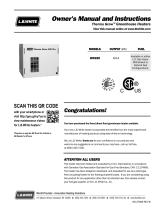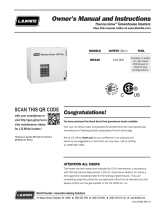
10
Venting
This water heater has been shipped with a draft diverter for which it was designed with
reference to the horizontal and vertical planes, its certified category I, per latest ANSI Z
21.10.3-2015.CSA 4.3-2015 revision. Refer to the latest edition of the National Fuel
Gas Code (ANSI Z223.1-latest edition), or in Canada, the Natural Gas and Propane
installation Code (B149.1-00 latest edition). If removed, the draft diverter must be
replaced in the same position and secured to the jacket top by the screws with which it
was installed.
WARNING
The venting system must be installed properly following all local codes
or in the absence of local codes, the latest edition of the National Fuel
Gas Code (ANSI Z223.1- latest edition), or in Canada, The Natural Gas
and Propane Installation Code (B149.1-00 latest edition). Failure to
properly install the venting system could result in property damage,
personal injury, or death.
WARNING
Carefully inspect the venting system of a replacement water heater installation
before connecting to the venting system. All joints in the vent connector must be
securely fastened with screws and fit tightly together. Inspect the venting
system for signs of deterioration (rust and perforation) and replace any sections
that are not in good condition.
The chimney must be lined and in good condition. Check to make sure the
venting system is properly sized for the water heater. If the venting system was
previously sized for another gas appliance that has been removed, the venting
system may now be too large. Refer to the latest edition of the National Fuel
Gas Code (ANSI Z223.1-latest edition), or in Canada, the Natural Gas and
Propane Installation Code (B149.1-00 latest edition) for the correct sizing of
venting systems and common venting with another gas appliance.
Do not vent this water heater into the venting system of another gas appliance
designed to vent under positive pressure.
The water heater should be installed as close as practical to the venting system
to minimize the vent connector length required. Refer to local codes for the
distance limitations on vent connector lengths.
At the completion of the water heater installation, the burner and venting system
must be checked for proper operation with all other commonly vented
appliances in operation. Check for spillage of flue products around the outside
relief opening of the draft hood after several minutes of operation. The flame
from a match should be drawn into the draft hood. Do not use the water heater
or connected equipment if spillage is detected until the problem is corrected.
Refer to the latest edition of the National Fuel Gas Code, or in Canada, the
Natural Gas and Propane Installation Code for complete details on the
“Procedure to Be Followed to Place Equipment in Operation”.






















